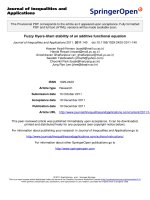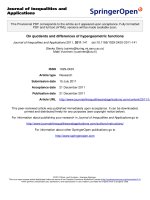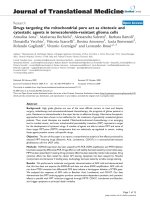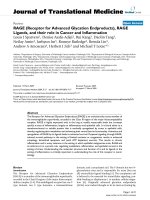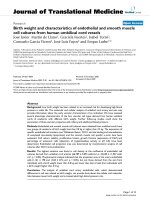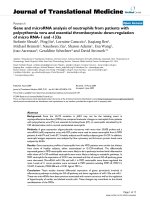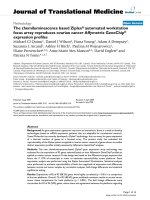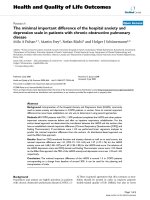Báo cáo hóa học: " Robotically facilitated virtual rehabilitation of arm transport integrated with finger movement in persons with hemiparesis" potx
Bạn đang xem bản rút gọn của tài liệu. Xem và tải ngay bản đầy đủ của tài liệu tại đây (796.13 KB, 10 trang )
RESEARCH Open Access
Robotically facilitated virtual rehabilitation of arm
transport integrated with finger movement in
persons with hemiparesis
Alma S Merians
1*
, Gerard G Fluet
1
, Qinyin Qiu
3
, Soha Saleh
3
, Ian Lafond
3
, Amy Davidow
2
and
Sergei V Adamovich
1,3
Abstract
Background: Recovery of upper extremity function is particularly recalcitrant to successful rehabilitation. Robotic-
assisted arm training devices integrated with virtual targets or complex virtual reality gaming simulations are being
developed to deal with this problem. Neural control mechanisms indicate that reaching and hand-object
manipulation are interdependent, suggesting that training on tasks requiring coordinated effort of both the upper
arm and hand may be a more effective method for improving recovery of real world function. However, most
robotic therapies have focused on training the proximal, rather than distal effectors of the upper extremity. This
paper describes the effects of robotically-assisted, integrated upper extremity training.
Methods: Twelve subjects post-stroke were trained for eight days on four upper extremity gaming simulations
using adaptive robots during 2-3 hour sessions.
Results: The subjects demonstrated improved proximal stability, smoothness and efficiency of the mov ement path.
This was in concert with improvement in the distal kinematic measures of finger individuation and improved
speed. Importantly, these changes were accompanied by a robust 16-second decrease in overall time in the Wolf
Motor Function Test and a 24-second decrease in the Jebsen Test of Hand Function.
Conclusions: Complex gaming simulations interfaced with adaptive robots requiring integrated control of
shoulder, elbow, forearm, wrist and finger movements appear to have a substantial effect on improving
hemiparetic hand function. We believe that the magnitude of the changes and the stability of the patient’s
function prior to training, along with maintenance of several aspects of the gains demonstrated at retention make
a compelling argument for this approach to training.
Background
Sensorimotor impairments and participation restrictions
remain a pervasive problem for patients post stroke,
with recovery of upper extremity function particularly
recalcitrant to intervention. 80% to 95% of persons
demonstrate residual upper extremity impairments last-
ing beyond six months after their strokes [1]. One of
the issues that may contribute to less than satisfactory
outcomes for the upper extremity is the complexity of
sensory processing and motor output involved in normal
hand function. There is a vital need to develop rehabili-
tative training strategies that will improve functional
outcomes and real-world use of the arm and hand. In
an attempt to address this need, many researchers are
developing robotic-assisted arm training devices in con-
cert with strategically placed virtual targets or complex
virtual reality gaming simulations. Integrated whole arm
activities are difficult because most robotic devices are
designed for upper arm motion and not for grasp and
fine motor activities. An additional hurdle stems from
multiple lines of inquiry in animal and human motor
learning and neuroplastici ty literature, that indicate that
sufficient task complexity seems to b e a factor in upper
extremity motor skill development and cortical plasticity
* Correspondence:
1
Department of Rehabilitation and Movement Sciences, University of
Medicine and Dentistry of New Jersey, Newark, NJ
Full list of author information is available at the end of the article
Merians et al. Journal of NeuroEngineering and Rehabilitation 2011, 8 :27
/>JNER
JOURNAL OF NEUROENGINEERING
AND REHABILITATION
© 2011 Merians et al; licensee BioMed Central Ltd. This is a n Open Ac cess article distributed under the terms o f the Cre ative Commons
Attribution License ( which permits unrestr icted use, distribution, and re production in
any medium, provided the original work is properly cited.
[2-5], requiring more complex training activities than
those typically seen in the robotic rehabilitation
literature.
In an effort to improve upper extremity outcomes
post-stroke we have concentrated on hand training. Our
past work has used virtual reality gaming simulat ions to
exercise finger movements of a stationary hand, includ-
ing functional individual finger mot ions and whole hand
opening/closing, to interact with simple interactive vir-
tual environments. Subjects showed improvement in the
kinematics of the movements as well as in dexterity a s
measured by clinical tests of hand function [6-8]. This
intervention utilized current neurophysiological findings
regarding the importance of repetitive, frequent and
intensive practice for skill development and motor
recovery [9-13].
As we do not know the best training strategy to facili-
tate recovery of hand function and recognizing the
neural interaction of arm and hand and the importance
of training using functionally complex movements, we
asked the question whether training the arm and hand
in an integr ated manner would promote better motor
recovery outcomes than previously reported hand-only
training. In this paper we describe a study that used
interactive gaming simulations interfaced with adaptive
robots to provide a multi-faceted environment to test
the assumption that training the entire upper extremity,
including fingers, as a unit will improve the hemiparetic
hand of patient s post-stroke and import antly that the
kinematic changes g ained through this type o f practice
would transfer to untrained real world arm/hand
activities.
Methods
System
Hardware
All simulations in this study utilized CyberGlove
©
(Immersion) instrumented glov es for hand tracking. A
CyberGrasp
©
(Immersion), a lightweight, force-reflecting
exoskeleton that fits over the CyberGlove was used to
facilitate individual finger movement in patients with
more pronounced deficits. Two of the four simulations
use the Flock of Birds (Ascension Technologies) motion
sensors for arm tracking and the other two use the Hap-
tic Master robot (Moog FCS Corporation). Please s ee
[14,15] for full description of the hardware.
Simulations
Four gaming sim ulations were developed. All four simu-
lations integrate components of upper arm movement
with wrist and hand move ment.
Plasma Pong
©
(Steve
Taylor, 2007) was adopted from an existing game in
which the game control was transferred from the com-
puter mouse to the CyberGlove. In this game (Figure
1a), the pong paddle is moved vertically using shoulder
flexion/extension while the moving ball is engaged hori-
zontally, using rapid finger extension. The
Humming-
bird Hunt simulation depicts a hummingbird moving
through an environment filled with trees, flowers and a
river (Figure 1b), providing practice in the composite
movement of arm transport, hand-shaping and grasp. A
pincer grip is used to catch and release the bird while it
is positioned in different locations of a 3D workspace.
The
Hammer Task (Figure 1c) trains a combination of
three dimensional reaching and repetitive finger flexion/
extension. The subjects reach toward a virtual wooden
cylinder, stabilize their upper arm and then use either
finger extension or flexion to hammer the cylinders into
the floor. The
Virtual Piano simulation consists of a
complete virtual piano (Figure 1d) that plays the appro-
priate notes as they are pressed by the virtual fingers
using the CyberGlove with or without the CyberGrasp.
Please see [7,16] for full description of the simulations.
Figure 1e shows the experimental set-up for the integra-
tion of the Haptic Master robot, the arm supporting
gimbal and the CyberGlove.
Subjects
Twelve subjects (8 male, 4 female), mean (SD) age of 55
(14) years, and mean (SD) time post stroke of 5 (5)
years, (range 9 months to 15 years) participated in this
study. Inclusion criteria were sub jects at least 6 months
post-stro ke, wrist extension o f at least 10°, finge r exten-
sion of 10° and not receiving any other therapy at the
time of the study. Exclusion criteria included severe
aphasia, hemispatial neglect and botulinum toxin injec-
tions within the past 3 mon ths. The Chedoke McMaster
Arm(CMA)andHand(CMH)ImpairmentInventories
[17] and a composite of upper extremity Ashworth
scores were used to categorize the impairment levels of
the subjects (see Table 1 for demographic and impair-
men t data). Consent was obtained from all subjects and
the Internal Review Boards of both universities approved
the protocol. Subjects trained o n all four simulations
during 2-3 hour sessions for eight days. Training was
divided equally between the four simulations. Total
training time started on day one at two hours and
increased in fifteen-minute increments during Week 1.
Training time started and remained at three hours on
all four days of Week 2.
Measurement
Two timed clinical tests serve d as our primary outcome
measures: Jebsen Test of Hand Function (JTHF) and
Wolf Motor Function Test (WMFT) [18,19]. Both the
impaired and unimpaired arm/hand were tested for each
clinical test. For the WMFT 120 seconds were recorded
when the subject could not perform the subtest [20],
while for the JTHF we used 45 sec as a score for a failed
Merians et al. Journal of NeuroEngineering and Rehabilitation 2011, 8 :27
/>Page 2 of 10
subt est. Similar to other reported studies, we eliminated
the writing component of the JTHF [6,21]. In each ses-
sion, the JTHF was administered three times and the
mean of the three scores was used for analysis. Stroke
subjects were tested prior to training, immediately post
training and at least three months after training. Sub-
jects were at least 6 months post-stroke and reported to
be neurologically stable. To confirm the stability of their
motor function and absence of confounding sponta-
neous recovery, for each clinical test, we conducted two
baselin e tests on a subset (N = 8), of the twelve subjects
with stroke, t wo weeks before and one day before the
onset of training. In addition, seven age-matched, neuro-
logically healthy subjects performed the JTHF, three
times, at two- week intervals, three times per session.
The secondary measures were the kinematic measures
obtainedfromtheHammertaskandtheVirtualPiano.
We have designed the simulation tasks to have both dis-
crete and continuous movements. The Virtual Piano
and the Hammer Task consist of discrete movements
with a definite beginning and end, making them more
amenable to kinematic analyses. For the Hammer task,
these included, hand-path length, maximal extension of
the Metacarpal-phalangeal joints (MPJ), time to com-
plete the task (duration) which includes the reaching
and hammering phase for each cylinder, the smoothness
of the hand trajectory and the deviation of the wrist
position in 3D space during hammering [22]. Smooth-
ness of the trajectories w as evaluated by integrating the
third derivative of the trajectory length. This numerically
describes the ability to produce smooth, coordinated,
reaching movements [14,23]. Hand deviation was mea-
sured as the mean distance of the hand from the target
during hammering (using finger flexion and extension)
and is considered a measure of proximal stability and
shoulder stabilization during hand-object interaction
[22]. For the Virtual Piano, kinematic measures included
accuracy, measured by the percent of correct key
presses, time to complet e the task (duration), which
includes both hand transport and key press time for
each note in the song, and fractionation, the ability to
Figure 1 Simulations. Screen shots for simulations utilized during this training study a. Plasma Pong, b. Hummingbird Hunt, c. Hammer Task, d.
Virtual Piano. e. Training setup.
Table 1 Subject characteristics
Subject Age Years Post CVA Gender CMA CMH Ashworth
a
S1 63 3 yrs Male 6 5 3
S2 53 10 mo Female 7 4 5
S3 68 15 yrs Male 4 3 7
S4 54 2 yrs Male 6 4 3
S5 70 8 yrs Female 7 5 1
S6 72 12 yrs Male 5 4 6
S7 61 4.5 yrs Female 5 5 4
S8 62 1.5 yrs Male 6 6 3
S9 25 9 mo Male 5 4 5
S10 47 9.5 yrs Male 4 3 6
S11 38 3 yrs Female 6 6 3
S12 54 11 mo Male 7 6 0
Abbreviations: CMA, Chedoke McMaster Arm Stage; CMH, Chedoke McMaster
Hand Stage; yrs, years; mo, months.
a
Ashworth denotes Composite of Ashworth Grades for Shoulder Extensors,
Elbow Flexors and Wrist Flexors.
Merians et al. Journal of NeuroEngineering and Rehabilitation 2011, 8 :27
/>Page 3 of 10
isolate the movement of each finger, measured as the
difference in MCP joint angle betw een the c ued finger
and the most flexed non-cued finger.
Data Analysis
The subjects were evaluated three times on the primary
outcome measures, with two pre-planned contrasts: Pre-
test minus Post-test, and Pre-test minus Retention-test.
Data sets for pre-test, post-test and retention were each
evaluated for normality using the Kolmogorov-Smirnov
Test. While JTHF scores were normally distributed (p >
0.20), scores for the WMFT were positively skewed (p <
0.1) because of two of the most involved subjects. We
have performed all statistical tests using clinical scores
of all 12 subjects, as well as of 10 subjects (with the two
most involved subjects removed), with similar results.
Therefore, we will report the outcomes of parametric
statistical tests on all 12 subjects. At t he same time, the
Pre_minus_Post and Pre_ minus_Retention differences
in the WMFT and JTHF clinical scores of the 12 sub-
jects were normally distributed (p > 0.2). Therefore, we
will use these data to compare the mean percent
improvement between the Pre-test and Post-test s cores
demonstrated by subjects in this study with those in our
previous studies (see Discussion).
For the clinical measures, first, the combined scores of
the two tests (WMFT, JTHF) were subjected to a
repeated measures ANOVA with factors Test (JTHF,
WMFT) and Measurement Time (Pre-test, Post-test,
Retention). The Pre-test score was calculated as an aver-
age of the two baseline scores for subjects with two pre-
training measurements obtained two weeks and one day
before the training. Preplanned post-hoc comparisons,
Pre-test versus Post-test and Pre-test versus Retention
were made for the combined clinical test using two
separate, repeated measures ANOVAs with repeated
measures of Test (JTHF, WMFT) and Measurement
Time (Pre-test, Post-test) or Measurement Time (Pre-
test, Retention). The degrees of freedom for all ANOVA
tests were adjusted using Greenhouse-Geisser correc-
tions. Finally, preplanned post-hoc comparisons, Pre-test
versus Post-test and Pre-test versus Retention were
made using two separate, repeated measures ANOVAs
for each of the two tests. Eta-squared statistics were
used to calculate estimates of effect sizes for group
comparisons.
All the kinemat ic measurements described above were
normally distributed. To derive a start measure (SM),
performance scores were pooled over the first two days
of therapy in order to enhance data stability and reduce
potential effects due to subjects acclimating to the
robotic system and the virtual environments on Day 1.
Performance scores from the last two days were also
pooled to obtain a larger da ta sample for enhanced data
stability of the end measure (EM) [6,24]. For the Ham-
mer Task four separate repeated measures ANOVAs
with factor, Measurement Time (SM, EM) were used to
evaluate changes in arm kinematics (Duration, Hand
Path Length, Smoothness and Hand Deviation). For the
Piano task, three separate repeated me asures ANOVAs
with factor, Measurement Time (SM, EM) were used to
evaluate c hanges in hand kinemati cs (Fractionation,
Duration, Accuracy).
The percent change in the mean clinical scores was
calculated as 100 multiplied by the difference between
Pre-test and Post-test mean scores, divided by Pre-test
mean score. This allowed for a comparison with t he
outcomes of a former study where we used the previous
version of our VR training system [6]. For kinematic
measures, the percent changes were calculated in similar
fashion using starting measure SM and end measure
EM as described above.
Results
Kinematic Analyses
Figure 2 displays the group average daily change in the
Piano task for finger fractionation (2a), average move-
ment duration for each note in a song (2b), accuracy of
key presses (2c). Two subjects needed t o use haptic
assistance from the CyberGrasp for this activity and
were therefore eliminated from the group calculations
for fractionation (ability to isolate their finger move-
ment). As a gro up the other ten subjects significantly
improved in fractionati on (Table 2) showing a 39%
change. There was a significant improvement in the
time to complet e the task showing a 19% change with-
out a subsequent change in accuracy (Table 2), indicat-
ing that the subjects were able to do the task faster
without a substantive change in accuracy. This is
thought to be consistent with motor learning [25].
Figure 3 summarizes group changes during the Ham-
mer task in t he hand path length (3a), duration (3b),
smoothness of the arm trajectories (3c), peak MPJ
extension (3d), group changes in hand deviation (3e)
and individual subject improvement in hand deviation
(3f). There was a significant decrease i n four of the five
kinematic variables (Table 2). The time needed to com-
plete each hammering task decreased, showing a 47%
change. The hand path decreased in length, by 41% and
improved in smoo thness by 76%. The improvement in
movement time and path length appears to be related to
changes in proximal segment func tion as finger exten-
sion (3d), did not change significantly. A decrease in
end-point deviation is an indi cator of proximal stability.
As a group, the subjects improved the proximal stabilit y
of the arm while the fingers were repeatedly extending
during the hammering task (Table 2), showing a 51%
change. Figure 3f indicates that eleven of the t welve
Merians et al. Journal of NeuroEngineering and Rehabilitation 2011, 8 :27
/>Page 4 of 10
subjects improved in this measure with smaller bars
indicating less superfluous proximal segment movement
while distal segments interacted with the target. Lang
cites the ability to maintain proximal segments station-
ary during distal task pe rformanc e as an importa nt con-
struct in overall upper extremity functional ability [26].
Clinical Analyses
First, we evaluated the effects of training on the combined
clinical score of the two ti med tests ( WMFT, JTHF) that
served as our primary outcome measures. The repeated
measures ANOVA showed a significant effect of Measure-
ment Time (F(2,22) = 13.2, G-G adjusted p = 0.002, partial
eta-squared 0.55, observed power (at al pha = 0.05) equ al
to 0.99), with no significant Clinical Test × Measurement
Time interaction. The subsequent separate ANOVAs with
a repeated factor Measur ement Time (Pre- test, Post-test,
Retention) demonstrated statistically significant effects of
training for each individual clinical test, WMFT (F(2,22) =
8.35, G-G adjusted p = 0.01, eta squared = 0.43, observed
power 0.94) and JTHF (F(2,22) = 9.92, G-G adjust ed p =
0.001, eta squared = 0.47, observed power 0.97). Finally,
both pre-planned post hoc comparisons ( Pre-test versus
Post-test and Pre-test v ersus Retention) f or e ach of the
two individual clinical tests were also significant (Table 3).
As a group, the 12 subjects showed a percent improve-
ment from Pre-test to Post-test of 22% in the WMFT (eta
squared = 0.83) and 20% in the JTHF (eta squared = 0.71).
In a separate analysis on a subset of eight subjects, we
verified the absence of spontaneous recovery by con-
ducting two baseline tests, two weeks before and one
day before the beginning of the training. Scores fo r both
WMFT and JTHF were normally distributed (Kolmo-
gorov-Smirnov normality test, p > 0.10). A repeated
measures ANOVA with factors Clinical Test (WMFT,
JTHF) × Measurement Time (Pre-test 1, Pre-test 2,
Post-test, Retention) showed a significant effect of Time
(F(3,21) = 10.7; G-G adjusted p = 0.001). Pre-planned
post-hoc tests (Pre-test 1 versus Pre-test 2 and Pre-test
2 versus Post-test) showed no difference between the
Pre-test 1 a nd Pre-test 2 for the composite clinical test
(F(1,7) = 0.73, p = 0.42) while the composite clinical
score at Post-test was significantly better than at Pre-
test 2 (F(1,7) = 12.75, p = 0.009). The interaction effect
of Clinical Test × Measurement Time was non-signifi-
cant. Separate repeated measures ANOVAs showed no
significant difference in the baseline scores between Pre-
test 1 and Pre-test 2 in any of the clinical tests. Mean
(SD) scores for WMFT were equal to 53.6 (15.6) and
54.6 (11.0); and for JTHF were equal to 100.3 (38.8) and
103.4 (36.4), respectively. At the same time, Post-test
mean (SD) scores were significantly better: 40.0 (8.4) for
B
B
B
B
B
B
B
B
12345678
0
10
20
30
40
50
60
Accuracy (%)
Trainin
g
Da
y
B
B
B
B
B
B
B
B
12345678
0
5
10
15
20
25
30
35
40
Fractionation (
d
eg
)
Trainin
g
Da
y
a
B
B
B
B
B
B
B
B
12345678
0
1
2
3
4
5
6
7
8
9
Duration (sec)
Trainin
g
Da
y
b
c
Figure 2 Piano trainer kinematic analyses. a. Daily averages during Virtual Piano training for finger fractionation defined as the difference
between the angle of the MCP joint of the cued finger and of the most flexed non-cued finger. Higher scores indicate better performance.
Averages for 10 subjects are shown (two subjects who used the CyberGrasp haptic device during virtual piano training are not included in this
analysis). 2b. Daily averages for all 12 subjects in the time to press each key during piano training. 2c.Daily averages of number of correct keys
pressed divided by total keys pressed for all 12 subjects. Error bars = Standard Error of the Mean.
Table 2 Kinematic variables
Pre-Test Post-Test F P
Virtual Piano Trainer
Finger Fractionation (deg)
a
23.3 (18.8) 33.0 (10.2) 5.7 0.044
Time to Press Each Key (sec) 5.82 (2.4) 4.72 (1.6) 5.4 0.04
Accuracy
a
0.44 (0.17) 0.40 (0.23) 0.54 0.48
Hammer Task
Time per Cylinder (sec) 31 (19) 15 (7) 13.6 0.005
Arm Endpoint Path Length (m) 1.2 (.62) 0.72 (.23) 14.7 0.003
Arm Endpoint Smoothness, *10
3
62.03 (86.7) 15.1(16.4) 5.2 0.05
Arm Endpoint Deviation 87 (50) 42 (19) 19.2 0.002
Peak MPJ Extension 22.5 (16) 19.5 (19) 2.42 0.16
Abbreviations: MPJ, Metacarpal-phalangeal joint.
a
For all measures except finger fractionation and accuracy, lower scores
indicate better performance.
b
Mean (standard deviation)
Merians et al. Journal of NeuroEngineering and Rehabilitation 2011, 8 :27
/>Page 5 of 10
WMFT and 84.6 (39.0) for JTHF. These a nalyses indi-
cate the stability of the subjects’ motor function prior to
training as evaluated by our two clinical tests.
Interpretive measures of clinical outcomes
Six out of 12 subjects demonstrated a percent improve-
ment in their WMFT score s after 8 days o f intensive
training larger than 30% (range: 30-41), while the other
half demonstrated smaller but still substantial percent
improvement (range: 10-24). The mean (95% CI)
decrease of 16 (13-22) sec in the WMFT time sub stan-
tially exceeds the reported group change of 2 seconds
needed to be regarded as a clinically important differ ence
on the WMFT [27]. To i ndicate a true change for an
individual subject in the time to complete the WMFT,
that is a change beyond possible measurement error, the
difference in score of an individual subject has to reach
4.36 sec [27]. In this study each subject exceeded the
minimum detectable change of 4.36 seconds (range 5.7
to 33.2 sec). Additionally, Wolf et al. [28] cite the com-
pletionofanitemonaclinical test of upper extremity
function at post-test, which a subject was unable to com-
plete at pre-test, as a clinically significant change. One
subject was unable to complete the checker task at pre-
test but was able to do it at the retention test. This same
subject was also unable to complete the picking up small
objects and self feeding tasks of the JT HF at p re-t est but
did complete them at post-test and retention. It is inter-
esting to note that these changes in hand dexterity were
observed in both clinical tests.
B
B
B
B
B
B
B
B
12345678
0
5
10
15
20
25
30
35
40
MPJ Extension (deg)
Training Day
B
B
B
B
B
B
B
B
12345678
0
0.5
1
1.5
2
2.5
3
Hand Path (m)
Training Day
B
B
B
B
B
B
B
B
12345678
0
20
40
60
80
100
120
140
160
180
200
Han
d
Deviation (cm)
Training Day
B
B
B
B
B
B
B
B
12345678
0
50
100
150
200
250
300
Smoothness (x10^3)
Training Day
B
B
B
B
B
B
B
B
12345678
0
10
20
30
40
50
60
Duration (sec)
Training Day
S1 S2 S3 S4 S5 S6 S7 S8 S9 S10 S11 S12
0
20
40
60
80
100
120
140
160
180
200
Hand Deviation (cm)
Sub
j
ects
Pre Post
ab
c
d
e
f
Figure 3 Hammer simulation kinematic analyses. Daily average for all twelve subjects duri ng H ammer Task training in a. the length of the
path required to complete ten targets. b. time required to hammer each virtual cylinder c. in hand trajectory smoothness quantified as
normalized integrated jerk (values are dimensionless, lower scores indicate smoother path with fewer subunits). d. peak finger extension. 3e.
hand deviation calculated as the cumulative excursion of the hand position in 3D space from the center of the target starting at the time target
is acquired until completion of hammering (lower scores indicate more stability). 3f. Individual subjects start measure (average of first two
training days), and end measure (average of last two training days) for all twelve subjects in average hand deviation during hammer task
training. Error bars = Standard Error of the Mean.
Table 3 Training Effects for Clinical Tests
Pre-test versus Post-test Pre-test versus Retention
Test F
1,11
PES
a
Power
b
F
1,11
PES
a
Power
b
WMFT 54.8 0.00001 0.83 0.99 0.4 0.008 0.49 0.99
JTHF 27.0 0.0003 0.71 0.84 8.1 0.02 0.43 0.74
Abbreviations: ES, Effect Size, WMFT, Wolf Motor Function Test, JTHF, Jebsen
Test of Hand Function
a
Effect sizes were calculated as partial eta squared.
b
Observed power at alpha = 0.05
Merians et al. Journal of NeuroEngineering and Rehabilitation 2011, 8 :27
/>Page 6 of 10
To evaluate the functional relevance of the observed
improvement in the JTHF scores, we compared the per-
formance of the hemiparetic arm with that of the arm
ipsilateral to the lesion, as well as with the scores of
nine age-matched, neurologically healthy c ontrols (Fig-
ure 4). All subjects were tested on three separa te occa-
sions, with two weeks between the tests. The control
subjects were able to complete the six activities of the
JTHF on average in 3 3 (95% CI: 29-38) sec using their
dominant hand and in 36 (31-41) sec using their non-
dominant hand. The subjects with stroke required 49
(41-57) sec to complete the six activities using their
uninvolved hand and when using their impaired hand,
improved from 122 (90-154) sec to 98 (66-129) sec after
training. Measures for the uninvolved hand and the con-
trols were stable across the three time frames with only
the hemiparetic hand showing improved scores after
training.
It is believed that patients in the chronic phase post-
stroke, in general, are less physically active and do not
receive physical or occupational therapy. Therefore,
there is some concern that positive results of training
studiesareduemainlytothelargeincreaseofactivity
afforded by the training. To explore the impact of inac-
tivity on response to the intervention, we compared pre-
post-retention changes on the WMF T and the JTHF
between the subjects who had received physical therapy
within a three month period prior to beginning this
study (previously active group, N = 6, therapeutic inter-
vention within 3 months) and those who had not had
therapy for a longer time (previously inactive group, N
= 6, median time post therapeutic intervention = 14
mos.). We evaluated the effects of training on the com-
bined clinical score of the two timed tests (WMFT,
JTHF), using a repeated measures ANOVA with a
between factor Group (previously active, inactive) and a
within factor Measurement time (Pre-test, Post-test,
Retention). There was no difference between the two
groups (F(1,10) = .06; p = 0.82). Moreover, the Group
by Measurement time interaction was not significant (F
(2,20) = . 260; p = 0.77). These results indicate that the
prior l evel of activity did not affect the outcome o f the
training.
Discussion
In this study we tested a rehabilitation paradigm that
simultaneously exercised the arm and hand, including
the fingers, in an integrated manner using virtual reality
task-based gaming simulations. Our goal was to improve
hemiparetic hand function in patients in the chronic
phase post-stroke. As a group, the subjects were able to
more effectively control t he upper limb during reaching
and hand interaction with the target as demonstrated by
improved proximal stability, smoothness and efficiency
of the movement path. The improvements in smooth-
nessareindicativeofadecreaseinthenumberofsub-
movements required to complete the transport phase of
the motion. Several authors cite this pattern of change
as consiste nt with improvements in neuromotor control
[9,23]. This improved control was in concert wit h
improvement in the distal kinematic measures of frac-
tionation and improved speed. Of note, these changes in
robotic measures were accompanied by robust changes
in the clinical outcome measures.
Several factors may have influenced the findings in
this study. Congruent with the motor learning and neu-
roplasticity literature, it is believed that the acquisition
of a motor skill follows a dose-response relationship
CVA Impaired
CVA Unimpaired
Controls Non-dominant
Controls Dominant
J
THF1
J
THF3
J
THF2
0
20
40
60
80
100
120
140
Composite Time
(
sec
)
Figure 4 Jebsen test of hand function comparison.The
composite time for the Jebsen Test of Hand Function at three
testing points for the 12 subjects with strokes (JTHF1 = Pre-test,
JTHF2 = Post-test, JTHF3 = Retention, Impaired Hand = open circles,
Unimpaired Hand = solid circles), and the seven aged matched
controls (Non-Dominant Hand = open triangles, Dominant hand =
solid triangles). Error bars = Standard Error of the Mean.
Merians et al. Journal of NeuroEngineering and Rehabilitation 2011, 8 :27
/>Page 7 of 10
[29]. In rehabilitation, the dose is often measured as the
number of task repetitions or practice hours. Multiple
authors cite the ability of robotically facilitated training
to provide highly repetitious training as a key factor for
its effectiveness [30,31]. The comparison between the
training volume typical to robotic interventions and
those of trad itional UE interventions is marked. Subjects
average over 500 repetitions/day in studies in the
robotic rehabilitation literature [32-34] while an obser-
vational study of the repetitions performed in a tradi-
tional outpatient setting averaged 85 [35]. The average
number of repetitions during the two t o three hour
training sessions used in this study exceeded 2200.
Based upon a review o f 20 RCT’ s, it has been sug-
gested that a minimal dose of at least sixteen hours of
practice is required to achieve functional changes [29].
Our subjects performed 22 hours of training, 10 hours
during week one and 12 hours in the longer sessions in
week two. Each training session in this study was con-
siderably longer than the twenty to ninety minute ses-
sions described in the current robotic literature [30,31]
and was delivered within a more co ncentrate d time per-
iod [11,34,36-38].
Anotherfactortoconsideristhatthegamingsimula-
tions structured the subjects’ attentional focus. It has
been shown in people with and without disabilities that
the learning of a motor task is more effective when
attention is fo cused on externally rather than on intern-
ally based directions [39,40]. In these virtual reality
simulations, practice was directed to achieve action
goals rather than performing specific movements. The
instructions for the game, the feedback provided and
the inherent structure of eac h simulation directed the
players’ attention to the task to be achieved. In other
words, the focus of attention was on the effect of one’s
movements rather than on the movement itself.
The largest improvements demonstrated with the Vir-
tual Piano were for finger fractionation, which is the
ability to flex one finger independently of the other fin-
gers. During practice, the performance feedback, the
sound of the appropriate note, occurs when a fract iona-
tion target is achieved, reinforcing this construct. In
addition fracti onation is also specifically reinforced with
an adaptive algorithm that increases and decreases the
fractionation target, based on the subjects’ performance.
This algorithm which is described in detail elsewhere
appears t o help progress the subject towards improved
finger function [15]. Subjects made larger improvements
in fractionation than speed or accuracy that were not
shaped with an algorithm or reinforced with fee dback.
Similarly, subjects also failed to make improvements in
peak finger extension, which was no t reinforced with an
algorithm, during Hammer Task training. These results
are congruent with those of Lum et al. [37] who found
that subjects with strokes, training using the MIME sys-
tem, reduced force direction errors when this construct
was shaped with an algorithm.
Day three training performance for the three proximal
kinematic measures (hand deviation, path length and tra-
jectory smoothness), deviates from the trend of daily
incremental improvement during the rest of the trial (See
Figure 3). Three subjects, all with chronic strokes had
their worst performance on day three for these measures.
This may be secondary to higher levels of fatigue asso-
ciated with the initiation of an intense training protocol in
these subjects. A comparable pattern of high levels of fati-
gue during the early days of a trial has been demonstrated
by a group of CIMT subjects with chronic strokes [41].
Our overarching goal is to integrate d evelopment of
robotic assisted training devices with the most effective
training paradigm for recovery of hand function. It is
therefore important to compare the changes in JTHF
time in this current study to other studies performed in
our lab. In a former study of comparable duration, that
trained the hand only, the subjects showed a 10%
improvement in the time of the JTHF [6], while in this
current study that trained the arm and hand simulta-
neously, there was a 24 sec decrease in the time to com-
plete the JTHF achieved by the subjects in this study,
which was equal to a 20% change in the time needed to
complete all the items on the JTHF. This decrease in
time represents 27% of the difference between the initial
scores of the stroke subjects, and the aged matched con-
trols. Moreover, it represents 33% of the difference
between the initials scores of the impaired and unin-
volved hand. Given this robust improvement as well as
the difference between initial scores for the impaired
arm and the less impaired arm, one c an suggest that
functional changes may have occurred secondary to this
training. Future analyses would be required to relate this
robust change in the JTHF with changes in activities o f
daily living function.
Essential factors suc h as t he dosage an d intensity of
the practice, the focus of attention on the movement
outcome, and the drive provided by specific algorithms
are important to achieving functional outcomes. How-
ever , these facto rs have been similar in our past studies.
What was different in this study was the complexity of
the movements required to interact with the virtual
simulations. When we trained the hand alone, the gam-
ing simulations were very simple activities, requiring
only control of wrist and finger movement. Whereas in
this study the activities required by the gaming simula-
tions were more complex and required simultaneous
control of integrated shoulder, elbow, forearm, wrist and
finger movements. These factors appear to have had a
substantial, positive effect on our goal of improving
hemiparetic hand function.
Merians et al. Journal of NeuroEngineering and Rehabilitation 2011, 8 :27
/>Page 8 of 10
However, an important question to consider is
whether it is the complexity of the simulations or the
consistent training of integrated shoulder, elbow, fore-
arm, wrist and fing er movements that is responsible for
these improvements. This question engenders another
possible training variation. Will the findings be as robust
if the subjects train on complex activities that only
require independent and discrete upper arm movements
or hand movements. To answer this question our lab is
in the process of initiating a randomized controlled tr ial
testing f or the effect of integrated versus isolated train-
ing of proximal and distal upper extremity effectors to
compare the outcomes with our previous findings.
Conclusions
The quasi experime ntal data presented in this paper
lacks the controls necessary to make conclusive state-
ments about the efficacy of this treatment approach.
However, double baseline measures indicated that the
subjects in this study were neurologically stable. We
believe that the magnitude of the changes and the stabi-
lity of the patient’s function prior to training, along with
maintenance of several aspects of the gains demon-
strated at retention make a compelling argument that
this approach to training warrants continued study.
Acknowledgements
We would like to acknowledge Anita Van Wingerden, PT for her assistance
in testing the subjects. This work was supported in part by NIH grant
HD58301 and by the National Institute on Disability and Rehabilitation
Research, Rehabilitation Engineering Research Center Grant # H133E050011.
Author details
1
Department of Rehabilitation and Movement Sciences, University of
Medicine and Dentistry of New Jersey, Newark, NJ.
2
Department of
Quantitative Methods, University of Medicine and Dentistry of New Jersey,
Newark, NJ.
3
Department of Biomedical Engineering, New Jersey Institute of
Technology, Newark, NJ.
Authors’ contributions
All authors read and approved the final manuscript. ASM participated in the
robotic/VR system design, study design, data collection, data analysis, initial
manuscript preparation and manuscript revision. GGF participated in the
study design, subject recruitment, data collection, data analysis, initial
manuscript preparation and manuscript revision. QQ participated in the
robotic/VR system design, data collection, data analysis and initial
manuscript preparation. SS participated in the data collection, manu script
preparation and manuscript revision processes. IL participated in the data
collection, manuscript preparation and manuscript revision processes. AD
participated in the study design, data analysis and manuscript revision
processes. SVA participated in the robotic/VR system design, study design,
data collection, data analysis, initial manuscript preparation and manuscript
revision processes.
Competing interests
The authors declare no competing interests with respect to the authorship
and/or publication of this article.
Received: 5 November 2010 Accepted: 16 May 2011
Published: 16 May 2011
References
1. G Kwakkel, BJ Kollen, J van der Grond, AJ Prevo, Probability of regaining
dexterity in the flaccid upper limb: impact of severity of paresis and time
since onset in acute stroke. Stroke. 34, 2181–2186 (2003). doi:10.1161/01.
STR.0000087172.16305.CD
2. JR Carey, E Bhatt, A Nagpal, Neuroplasticity promoted by task complexity.
Exerc Sport Sci Rev. 33,24–31 (2005)
3. P Hlustik, A Solodkin, DC Noll, SL Small, Cortical plasticity during three-week
motor skill learning. J Clin Neurophysiol. 21, 180–191 (2004). doi:10.1097/
00004691-200405000-00006
4. RJ Nudo, GW Milliken, Reorganization of movement representations in
primary motor cortex following focal ischemic infarcts in adult squirrel
monkeys. J Neurophysiol. 75, 2144–2149 (1996)
5. SB Frost, GW Milliken, EJ Plautz, RB Masterton, RJ Nudo, Somatosensory and
motor representations in cerebral cortex of a primitive mammal
(Monodelphis domestica): a window into the early evolution of
sensorimotor cortex. J Comp Neurol. 421,29–51 (2000). doi:10.1002/(SICI)
1096-9861(20000522)421:13.0.CO;2-9
6. AS Merians, H Poizner, R Boian, G Burdea, S Adamovich, Sensorimotor
training in a virtual reality environment: does it improve functional recovery
poststroke? Neurorehabil Neural Repair. 20, 252–267 (2006). doi:10.1177/
1545968306286914
7. AS Merians, E Tunik, GG Fluet, Q Qiu, SV Adamovich, Innovative approaches
to the rehabilitation of upper extremity hemiparesis using virtual
environments. Eur J Phys Rehabil Med. (2008)
8. S Adamovich, Q Qiu, A Mathai, G Fluet, A Merians, Recovery of hand
function in virtual reality: training hemiparetic hand and arm together or
separately. IEEE Engineering in Medicine and Biology Conference;
Vancouver, Canada. 3475–3478 (2008)
9. HI Krebs, BT Volpe, M Ferraro, S Fasoli, J Palazzolo, B Rohrer, L Edelstein, N
Hogan, Robot-aided neurorehabilitation: from evidence-based to science-
based rehabilitation. Top Stroke Rehabil. 8,54–70 (2002). doi:10.1310/6177-
QDJJ-56DU-0NW0
10. RJ Sanchez, J Liu, S Rao, P Shah, R Smith, T Rahman, SC Cramer, JE Bobrow,
DJ Reinkensmeyer, Automating arm movement training following severe
stroke: functional exercises with quantitative feedback in a gravity-reduced
environment. IEEE Trans Neural Syst Rehabil Eng. 14, 378–389 (2006).
doi:10.1109/TNSRE.2006.881553
11. LE Kahn, PS Lum, WZ Rymer, DJ Reinkensmeyer, Robot-assisted movement
training for the stroke-impaired arm: Does it matter what the robot does? J
Rehabil Res Dev. 43, 619–630 (2006). doi:10.1682/JRRD.2005.03.0056
12. PS Lum, CG Burgar, M Van der Loos, PC Shor, M Majmundar, R Yap, MIME
robotic device for upper-limb neurorehabilitation in subacute stroke
subjects: A follow-up study. J Rehabil Res Dev. 43, 631–642 (2006).
doi:10.1682/JRRD.2005.02.0044
13. S Hesse, H Schmidt, C Werner, A Bardeleben, Upper and lower extremity
robotic devices for rehabilitation and for studying motor control. Curr Opin
Neurol. 16, 705–710 (2003). doi:10.1097/00019052-200312000-00010
14. SV Adamovich, GG Fluet, AS Merians, A Mathai, Q Qiu, Incorporating haptic
effects into three-dimensional virtual environments to train the hemiparetic
upper extremity. IEEE Trans Neural Syst Rehabil Eng. 17, 512–520 (2009)
15. SV Adamovich, GG Fluet, A Mathai, Q Qiu, J Lewis, AS Merians, Design of a
complex virtual reality simulation to train finger motion for persons with
hemiparesis: a proof of concept study. J Neuroeng Rehabil. 6, 28 (2009).
doi:10.1186/1743-0003-6-28
16. AS Merians, E Tunik, SV Adamovich, Virtual reality to maximize function for
hand and arm rehabilitation: exploration of neural mechanisms. Stud Health
Technol Inform. 145, 109–
125 (2009)
17.
C Gowland, P Stratford, M Ward, J Moreland, W Torresin, S Van Hullenaar, J
Sanford, S Barreca, B Vanspall, N Plews, Measuring physical impairment and
disability with the Chedoke-McMaster Stroke Assessment. Stroke. 24,58–63
(1993)
18. SL Wolf, PA Catlin, M Ellis, AL Archer, B Morgan, A Piacentino, Assessing
Wolf motor function test as outcome measure for research in patients after
stroke. Stroke. 32, 1635–1639 (2001)
19. RH Jebsen, N Taylor, RB Trieschmann, MJ Trotter, LA Howard, An objective
and standardized test of hand function. Arch Phys Med Rehabil. 50,
311–319 (1969)
20. JR Charles, SL Wolf, JA Schneider, AM Gordon, Efficacy of a child-friendly
form of constraint-induced movement therapy in hemiplegic cerebral palsy:
Merians et al. Journal of NeuroEngineering and Rehabilitation 2011, 8 :27
/>Page 9 of 10
a randomized control trial. Dev Med Child Neurol. 48 , 635–642 (2006).
doi:10.1017/S0012162206001356
21. AB Conforto, KN Ferreiro, C Tomasi, RL dos Santos, VL Moreira, SK Marie, SC
Baltieri, M Scaff, LG Cohen, Effects of somatosensory stimulation on motor
function after subacute stroke. Neurorehabil Neural Repair. 24, 263–272
22. Q Qiu, GG Fluet, I Lafond, AS Merians, SV Adamovich, Coordination changes
demonstrated by subjects with hemiparesis performing hand-arm training
using the NJIT-RAVR robotically assisted virtual rehabilitation system. Conf
Proc IEEE Eng Med Biol Soc. 1, 1143–1146 (2009)
23. B Rohrer, S Fasoli, HI Krebs, B Volpe, WR Frontera, J Stein, N Hogan,
Submovements grow larger, fewer, and more blended during stroke
recovery. Motor Control. 8, 472–483 (2004)
24. S Adamovich, A Merians, R Boian, M Tremaine, G Burdea, M Recce, H
Poizner, A virtual reality (VR)-based exercise system for hand rehabilitation
post stroke. Presence. 14, 161–174 (2005). doi:10.1162/1054746053966996
25. JW Krakauer, Motor learning: its relevance to stroke recovery and
neurorehabilitation. Curr Opin Neurol. 19,84–90 (2006). doi:10.1097/01.
wco.0000200544.29915.cc
26. CE Lang, JA Beebe, Relating movement control at 9 upper extremity
segments to loss of hand function in people with chronic hemiparesis.
Neurorehabil Neural Repair. 21, 279–291 (2007). doi:10.1177/
1545968306296964
27. KC Lin, YW Hsieh, CY Wu, CL Chen, Y Jang, JS Liu, Minimal detectable
change and clinically important difference of the Wolf Motor Function Test
in stroke patients. Neurorehabil Neural Repair. 23, 429–434 (2009).
doi:10.1177/1545968308331144
28. SL Wolf, CJ Winstein, JP Miller, E Taub, G Uswatte, D Morris, C Giuliani, KE
Light, D Nichols-Larsen, Effect of constraint-induced movement therapy on
upper extremity function 3 to 9 months after stroke: the EXCITE
randomized clinical trial. Jama. 296, 2095–2104 (2006). doi:10.1001/
jama.296.17.2095
29. G Kwakkel, Impact of intensity of practice after stroke: issues for
consideration. Disabil Rehabil. 28, 823–830 (2006). doi:10.1080/
09638280500534861
30. G Kwakkel, BJ Kollen, HI Krebs, Effects of robot-assisted therapy on upper
limb recovery after stroke: a systematic review. Neurorehabil Neural Repair.
22, 111–121 (2008)
31. J Mehrholz, T Platz, J Kugler, M Pohl, Electromechanical and Robot-Assisted
Arm Training for Improving Arm Function and Activities of Daily Living
After Stroke. Stroke. (2009)
32. ML Aisen, HI Krebs, N Hogan, F McDowell, BT Volpe, The effect of robot-
assisted therapy and rehabilitative training on motor recovery following
stroke. Arch Neurol. 54, 443–446 (1997)
33. M Ferraro, JJ Palazzolo, J Krol, HI Krebs, N Hogan, BT Volpe, Robot-aided
sensorimotor arm training improves outcome in patients with chronic
stroke. Neurology. 61, 1604–1607 (2003)
34. L Dipietro, HI Krebs, SE Fasoli, BT Volpe, N Hogan, Submovement changes
characterize generalization of motor recovery after stroke. Cortex. (2008)
35. CE Lang, JR MacDonald, C Gnip, Counting repetitions: an observational
study of outpatient therapy for people with hemiparesis post-stroke. J
Neurol Phys Ther. 31,3–10 (2007)
36. JJ Daly, N Hogan, EM Perepezko, HI Krebs, JM Rogers, KS Goyal, ME
Dohring, E Fredrickson, J Nethery, RL Ruff, Response to upper-limb robotics
and functional neuromuscular stimulation following stroke. J Rehabil Res
Dev. 42, 723–736 (2005). doi:10.1682/JRRD.2005.02.0048
37. PS Lum, CG Burgar, PC Shor, Evidence for improved muscle activation
patterns after retraining of reaching movements with the MIME robotic
system in subjects with post-stroke hemiparesis. IEEE Trans Neural Syst
Rehabil Eng. 12, 186–194 (2004). doi:10.1109/TNSRE.2004.827225
38. SE Fasoli, HI Krebs, J Stein, WR Frontera, N Hogan, Effects of robotic therapy
on motor impairment and recovery in chronic stroke. Arch Phys Med
Rehabil. 84, 477–482 (2003). doi:10.1053/apmr.2003.50110
39. G Wulf, NH McNevin, T Fuchs, F Ritter, T Toole, Attentional focus in
complex skill learning. Res Q Exerc Sport. 71, 229–239 (2000)
40. G Wulf, M Landers, R Lewthwaite, T Tollner, External focus instructions
reduce postural instability in individuals with Parkinson disease. Phys Ther.
89, 162–168 (2009). doi:10.2522/ptj.20080045
41. J Underwood, PC Clark, S Blanton, DM Aycock, SL Wolf, Pain, fatigue, and
intensity of practice in people with stroke who are receiving constraint-
induced movement therapy. Phys Ther. 86, 1241–1250 (2006). doi:10.2522/
ptj.20050357
doi:10.1186/1743-0003-8-27
Cite this article as: Merians et al.: Robotically facilitated virtual
rehabilitation of arm transport integrated with finger movement in
persons with hemiparesis. Journal of NeuroEngineering and Rehabilitation
2011 8:27.
Submit your next manuscript to BioMed Central
and take full advantage of:
• Convenient online submission
• Thorough peer review
• No space constraints or color figure charges
• Immediate publication on acceptance
• Inclusion in PubMed, CAS, Scopus and Google Scholar
• Research which is freely available for redistribution
Submit your manuscript at
www.biomedcentral.com/submit
Merians et al. Journal of NeuroEngineering and Rehabilitation 2011, 8 :27
/>Page 10 of 10
